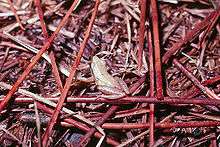Little grass frog
The little grass frog (Pseudacris ocularis) is a species of chorus frog endemic to the Southeastern United States.
| Little grass frog | |
|---|---|
 | |
| Scientific classification | |
| Kingdom: | Animalia |
| Phylum: | Chordata |
| Class: | Amphibia |
| Order: | Anura |
| Family: | Hylidae |
| Genus: | Pseudacris |
| Species: | P. ocularis |
| Binomial name | |
| Pseudacris ocularis | |
| Synonyms | |
| |
Description
P. ocularis is the smallest frog in North America, only reaching a maximum head-body length of 19 mm (0.75 in). It is normally pale brown, but can have a green or pink tinge.
Habitat
This species is mostly found around marshy swamps.
gollark: (a mobile phone, as you said)
gollark: <@319753218592866315> I roll for having a phone at home, d6.
gollark: Wait, hmm.
gollark: How much do *I* have?
gollark: My bee business is fairly successful, so I probably have money a bit.
References
- Hammerson, Geoffrey A. (2004). "Pseudacris ocularis". IUCN Red List of Threatened Species. 2004. Retrieved 12 May 2006.CS1 maint: ref=harv (link) Database entry includes a range map and justification for why this species is of least concern
- "Species Profile: Little Grass Frog". Savannah River Ecology Laboratory. Retrieved 2011-08-08.
Further reading
- Behler JL, King FW. 1979. The Audubon Society Field Guide to North American Reptiles and Amphibians. New York: Knopf. 743 pp. ISBN 0-394-50824-6. (Limnaoedus ocularis, p. 410 + Plate 172).
- Boulenger GA. 1882. Catalogue of the Batrachia Salientia s. Ecaudata in the Collection of the British Museum. Second Edition. London: Trustees of the British Museum. (Taylor and Francis, printers). xvi + 503 pp. + Plates I-XXX. (Chorophilus ocularis, pp. 333–334).
- Collins, Henry Hill Jr. 1959. Complete Field Guide to American Wildlife: East, Central and North. New York, Evanston, and London: Harper & Row. xix + 683 pp. + Plates 1-48. (Hyla ocularis, p. 443 + Figure 114 and map on p. 444).
- Conant R. 1975. A Field Guide to Reptiles and Amphibians of Eastern and Central North America, Second Edition. Boston: Houghton Mifflin. xviii + 429 pp. + Plates 1-48. ISBN 0-395-19979-4 (hardcover), ISBN 0-395-19977-8 (paperback). (Limnaoedus ocularis, pp. 326–327 + Plate 47 + Map 283).
- Holbrook JE. 1842. North American Herpetology; or, A Description of the Reptiles Inhabiting The United States. Vol. IV. Philadelphia: J. Dobson. 138 pp. + Plates I-XXXV. (Hylodes ocularis, pp. 137–138 + Plate XXXV).
- Wright AH, Wright AA. 1949. Handbook of Frogs and Toads of the United States and Canada. Third Edition. Ithaca, New York: Comstock. xxii + 640 pp. (Pseudacris ocularis, pp. 264–267, Plate LVI, map 18).
This article is issued from Wikipedia. The text is licensed under Creative Commons - Attribution - Sharealike. Additional terms may apply for the media files.
